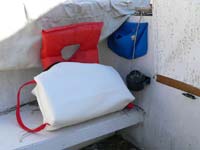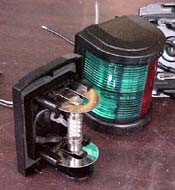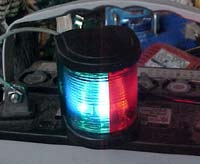Here are a couple boat ideas, one that is complete and ready to go (obviously, it’s not mine) and one that could use some input from Duckworks readers to make a more complete and neater item (yep, this one is mine).
The first is from Don Casey’s book, “100 Fast & Easy Boat Improvements.” On page 20, he tells how to take two of those ubiquitous rectangular orange life vests (class 2) that seem to be in the lockers and corners of every boat and make them into seat cushions. Basically you make a fabric bag (we used marine vinyl) with a Velcro-fastened opening through which the life vests fit.
|
The vinyl life jacket cushion cover, showing one of the two life vests that are used for padding. |
 |
|
See the book for instructions; Casey explains it better than we could.
What we wanted to mention is the cushions are unexpectedly comfortable, much better than the normal square cushions sold in marine stores. The reason is the collar cutout on the life vests provide some contouring to that sometimes hard to fit part of the human anatomy. Helen claims it’s the best cushion she’s ever used.
|
The cushion cover, ready for action. |
|
Other benefits are that the life jackets are on deck and ready to use, and the cushion makes a much better throwing floatation device than either a single life jacket or those square cushions.
The second idea came from my fascination (Helen says obsession) with LED lights, combined with noticing that the Lexan lenses on the running lights on the 30-footer had become very cloudy and crazed with age. Chuck at Duckworks told us the 39 mm festoon bulbs that we used to light much of the interior of our boat (See the article “LED Thoughts” in the January 2005 Duckworks) fit the running lights they sell. I ordered a bow and stern light.
There are two challenges here. One is LED bulbs aren’t as bright as incandescent bulbs, so you need more than one. They are also directional, so — especially on the bow light which covers more than 180 degrees — they must be aimed to get full, even coverage.
The lights have a wide metal tab on both top and bottom that would seem to encourage adding extra bulbs.
My first thought was to solder the bulbs in. To be brief, that just didn’t work. The solder didn’t want to stick well enough to the metal tabs. I gave up that approach.
|
The bow light cover and inside. The wide metal tabs at top and bottom encourage adding more that one bulb. The light here has a festoon bulb with 9 LEDs installed. |
 |
|
There seemed to be two other alternatives. Use bare copper wire and wire the bulbs in place, or cut some small pieces from a thin strip of brass on hand, drill holes for the pointy-ended bulbs, and make a wider mounting base. In the end, both methods were used. The stern light, where only two bulbs were used (the lens seemed to spread the light better than the bow light, there is less area to cover and the clear lens passes more light) got the wire. The bow light, with three bulbs, got the brass strips. (The pictures show some wire that was used to temporarily hold the strips and was left in place). On the forward light, one bulb is aimed almost directly sideways on each side and the middle bulb faces forward. On the stern light, each bulb is aimed about 45 degrees forward of the back plate. A dab of solder was used on each bulb to prevent any rotating out of position and the brass strips were also soldered in place, although friction is doing most of the work.
|
|
| The bow light, left, and stern light as modified. The wire ties on the bow light were temporary until some reinforcing solder could be added. Solder was added to both lights to ensure good electrical contact and to keep the bulbs, which have a narrow cone of projected light, from rotating out of position. |
|
My Mark 1 eyeball says this produces even illumination on both lights, and they seem plenty bright. We have portable, AA battery running lights that use two LED bulbs in each of red and green bow lights, and two in the white stern light and those are at least adequate. This arrangement has 27 LEDs in the bow, and 18 in the stern.
Power consumption is a real plus. Each of the incandescent bulbs in the lights were rated at 10 watts, or almost an amp each and around 1.75 amps total. The five LED bulbs together are rated at less than a fifth of an amp. They can run all night with less power than it would take to run the incandescents for two hours.
|
The stern light in its finished form. The two columns of light show where the bulbs are. The left bulb is actually airmed about 60 degrees away from the camera, but the light lens does a very good job of spreading the beam. The two bulbs provide a total of 18 LED lights. |
|
(I had a practical demonstration of how much less power is drawn by LEDs on the 30 footer. A voltmeter was hooked up to the 12-volt battery and every LED that was installed was turned on — four festoon bulbs, two other 8-LED dome-type lights, and three LED reading lights. After a couple minutes, the meter showed a drop of 0.02 volts. Then the old incandescent running lights, with 10-watt bulbs, were turned on for the same period of time. The voltage dropped by over half a volt.)
|
The bow light with three bulbs lit, or a total of 27 LEDs. The far right bulb, aimed 90 degrees away from the camera, doesn’t show too well from this angle, but the three bulbs provide even lighting. |
 |
|
While I’m pleased at the result with the lights, the construction is less than elegant and it seems like some Duckworks folks could have some ideas for improvements. We’re all ears . . . .

